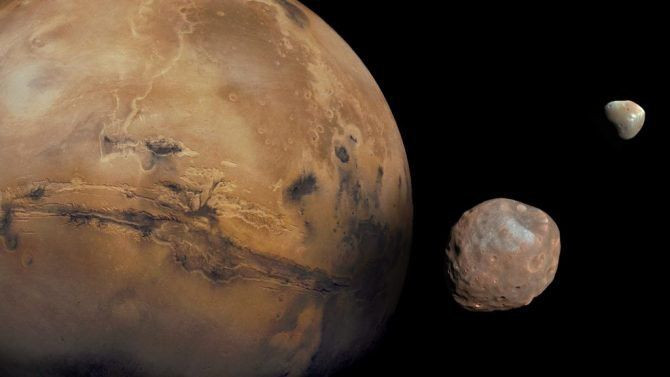Mars’ Tiny Moons Might Have Formed After Catastrophic Collision

A new model studying planetary evolution suggests Mars’ tiny moons, Phobos and Deimos, might have formed after the Red Planet’s catastrophic collision with an object nearly as big as the largest asteroids, Vesta and Ceres. The impact might have occurred during the chaotic early stages of the solar system’s formation — the time when Mars and other planets were still young.
For years, the origin story of the Martian moons has been debated. Some think the twins were captured into orbit as it is by the gravity of Mars, while others propose a more violent theory, one in which an equatorial disk of debris ejected by the planet’s collision with another space objects led to the formation.
A second theory has been widely suggested and sounds promising considering the similar case of planet Earth, but no one could detail the idea until the SwRI Space Science and Engineering Division came up with the first self-consistent model to show the type of impact that could have formed the two moons.
Using large-scale hydrodynamical simulations, they posited the impactor might have been as big as a dwarf planet, which would be somewhere close to the size of asteroid Vesta (326 miles wide) and Ceres (587 miles wide), but smaller than the body that collided with Earth to form our moon.
Nearly 4.5 billion years ago, a space object as big as Mars, which spans 4,200 miles in diameter, crashed into Earth to throw a 2,100 mile wide moon into its orbit. If we compare this with our Martian counterparts, Deimos and Phobos are very small and just measure 7.5 and 14 miles across, respectively.
According to a press release from the division, the outer portion of the disk ejected from the collision would have accumulated to form the two moons, while the inner would have formed larger moons, which eventually spiraled inwards and assimilated into Mars. Previous models focusing on larger moons did not prove viable.
“Larger impacts advocated in prior works produce massive disks and more massive inner moons that prevent the survival of tiny moons like Phobos and Deimos," Julien Salmon, another author of the study, said.
Among other things, the model also sheds light on the physical features of the two moons.
“The two moons are derived primarily from material originating in Mars, so their bulk compositions should be similar to that of Mars for most elements,” Robin Canup, the lead author of the work, said in a statement. “However, heating of the ejecta and the low escape velocity from Mars suggests that water vapor would have been lost, implying that the moons will be dry if they formed by impact."
The work, titled "Origin of Phobos and Deimos by the impact of a Vesta-to-Ceres-sized body with Mars," was published in Science Advances on April 18.
© Copyright IBTimes 2025. All rights reserved.




















